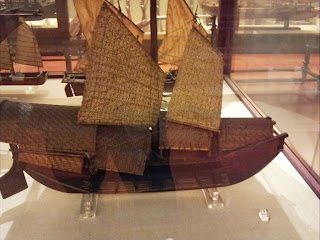Saturday, 11 March 2017
Models in the Madrid Naval Museum Part I
If you get tired of fine art at Madrid's incredible Prado museum, a nice break is the Museo Naval de Madrid, almost next door. Run by the Spanish armed forces, it has extensive exhibits of Spain's naval history, ranging from Columbus to the present-day Spanish navy. The exhibits are entirely in Spanish, so those who don't read the language have to be able to appreciate what they see without explanatory material.
In this post, we'll look at the museum's models of Philippine boats. Of course, the Philippines were a Spanish colony prior to the Spanish-American War, and the Spanish had plenty of opportunity to observe the local watercraft and collect models thereof.
The museum allows photography but not the use of flash which, combined with the fact that all the models are behind glass, partially explains the quality of the photos here. Click any image to enlarge. Captions are my inept translations of the Spanish exhibit cards. My own comments follow the main captions, in parentheses.
In this post, we'll look at the museum's models of Philippine boats. Of course, the Philippines were a Spanish colony prior to the Spanish-American War, and the Spanish had plenty of opportunity to observe the local watercraft and collect models thereof.
The museum allows photography but not the use of flash which, combined with the fact that all the models are behind glass, partially explains the quality of the photos here. Click any image to enlarge. Captions are my inept translations of the Spanish exhibit cards. My own comments follow the main captions, in parentheses.
 |
Philippine Prao(19th c.), Dugout for passengers and fishing. (double outrigger, Chinese-style reed-mat lugsails.) |
 |
| Banca(19th C.), Philippine, passenger vessel used in ports and bays; also for fishing. (Double outrigger, canoe-shape hull, multiple thwarts, European-style lugsail with a line of reefing points. No rudder: might have been steered with a paddle.) |
 |
Casco (19th C.), Philippine river cargo launch (To all appearances, a Chinese Sampan. Chinese-style mat sails look very small, are probably not to scale. Identification might be faulty. If so, probably my error.) |
 |
Panco (19th C.), Jolo, Philippines. Used for piracy. (Top view. This ungainly vessel seems unlikely for its stated use.) |
 |
Casco (19th C.), Philippine river cargo launch (Euro-style lugsails with vertical seams) |
 |
Guilalo (18th C.), Philippine, used especially on the Bay of Manila to transport passengers into the capital and Cavité. (Settee sails have an Indian Ocean flavor. Double outrigger. Clipper bow.) |
Subscribe to:
Post Comments (Atom)

No comments:
Post a Comment